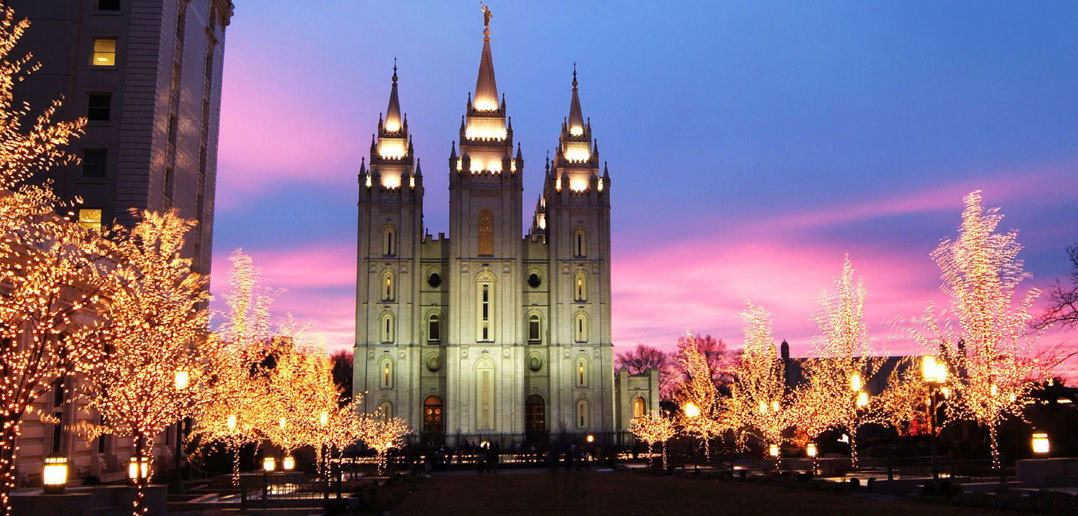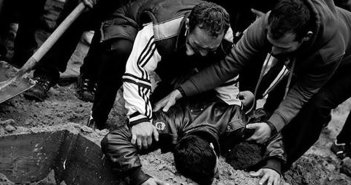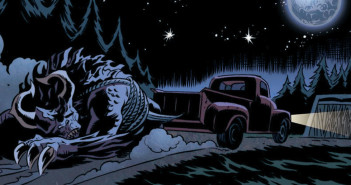“A person exhibiting sexual desire or behavior toward another person of one’s own sex,” is the definition Josh Moon found when he paged through a dictionary in search of the word “homosexual.” He had heard the term used while in grade school, resulting in his curiosity. After careful contemplation over the dictionary’s entry, Moon wondered if that was exactly what he was—a homosexual.
But Moon was in a more difficult position than many other American youths facing complex questions about their sexuality, all because of his faith. He was a Mormon, a religious circumstance that would make his sexual identity a tumultuous odyssey to realize.
RADICAL HERITAGE
As he grew up in Fort Worth, TX, the Church of Jesus Christ of Latter-day Saints (commonly referred to as “Mormonism”) was the center of Moon’s family and life. His father grew up in Utah, having descended from a long line of Mormon ancestors, while his mother was a convert. They both attended Brigham Young University (the premiere Mormon college), and held special positions known as “callings” within their religious community. As a boy, Moon and his parents would read scripture together and regularly partake in family prayers—the church was always an ever-present foundation on top of which the family built itself.
But the threat of Moon’s sexuality constantly loomed over him. At age 12, he told his parents that he wanted to quit Boy Scouts due to an incident where a group of boys pelted him with rocks while repeatedly yelling “faggot.” “I think at that moment my parents found out that I was gay, even before I really knew that I was,” Moon said.
The tidal wave of adolescence soon enveloped him—the emotional strain of growing up as a gay youth was crowned by the pressures he faced from his religion. Founded in 1830 by Joseph Smith, Mormonism bases its religious tenets on a set of golden plates that Smith claimed to have unearthed in New York State under the guidance of an angel. Among the values held by Mormons, the religion is family-intensive—vast importance is placed on marriage and child-rearing. Premarital sex is strictly forbidden and homosexuality is dually viewed as a sin and a mental illness.
But despite the challenges he faced, Moon decided to reveal his sexuality to his parents at age 14. His reason was straightforward: he wanted to live an honest life. Furthermore, he ultimately didn’t think there was anything wrong with being gay, despite his religious upbringing. Upon his revelation, Moon’s parents wanted to be supportive, but they also viewed the situation through the lens of Mormonism. “They expected me to want to change… We fought a lot during my teenage years, but they have come a long way and are very loving and supportive,” Moon said.
Now 26, Moon lives in Salt Lake City and is completing his education at the University of Utah. As an activist for equal human rights, he was saddened by the November 2008 passage of Proposition 8, an initiative to amend the California State Constitution banning same-sex marriage. The proposition (which only passed by a four-percent margin) was heavily funded by the time and money of Mormons.
Moon doesn’t practice religion anymore, either. As the years passed, he had trouble accepting the spiritual claims Mormonism offered, chief among them the Mormon Church’s inability to cast down its own institutionalized bigotry against the black community until 1978. But while he calls himself a humanist, he still has a great deal of respect for his heritage. “I still culturally identify as Mormon. I am really proud of my ancestors… these were radical people who were willing to die for what they believed in. I’m very proud of our history,” Moon said.
GUILT AND COMPROMISE
Many years before Josh Moon ever thumbed curiously through a dictionary, Toni Palmer found herself constantly distracted in her junior high seminary class. Instead of paying attention, she passed notes to her close friend, Laura. When their lessons bored them, they would ditch class altogether in order to have fun shoplifting and smoking. But Palmer and Laura’s friendship developed rapidly as they grew older, turning into something much more than a rebellious alliance.
Much like Moon, Palmer grew up in a strict Mormon household. “It was the basis for everything,” she said, emphasizing how important the religion was to her parents and five brothers and sisters. While growing up in Salt Lake City, she was immersed in an environment where church activities regularly occurred: camping trips, dances, firesides, and testimony meetings.
But the religious culture that surrounded Palmer caused her pained feelings as she realized she was attracted to other girls. Her attractions began at age seven, and progressed over the years into a series of crushes on various women, most of all her ninth-grade English teacher. Though her emotions flowed naturally, she couldn’t shake the religious beliefs that were inculcated into her since birth. “I felt a lot of shame and confusion… I was raised to believe that [homosexuality]was unnatural, sinful, and a mental illness; homosexuals were child molesters and predators,” Palmer said.
The supernatural worries that Palmer felt only complicated her journey of sexual acceptance on a socio-cultural level, which overwhelmed her at times. Denial was her only escape, and she would often tell herself that she was not a lesbian, but simply lonely and that her feelings were for only a select few women.
Palmer faced her greatest challenge upon meeting Laura. They originally met by walking to their mutual seminary class together, which was located just off of public school grounds. Originally shy, Palmer quickly warmed to Laura’s company and the two became fast friends. By the time their sophomore year began, the girls were inseparable, often “sluffing” (Utah slang for skipping class) in order to have fun.
The relationship between Palmer and Laura turned intimate by the eleventh grade, and though the two had strong feelings for one another, they broke up several times in order to “do the right thing.” Separation wasn’t a realistic option, however, and they eventually moved in together after graduating from high school. Slowly making other lesbian friends, they realized for the first time that they were not alone in the world.
At 19, Palmer decided to tell her family that she was a lesbian, an admission that received mixed reactions. Her mother worried that she had been brainwashed, while one of her sisters banned Palmer from ever babysitting her children again. Her father believed that homosexuality was a choice, but he also claimed to have known the truth. Though both faithful Mormons, Palmer’s brothers were not bothered by her sexuality.
In her early twenties, Palmer began to seriously question the church that once defined her life. “I had come to the realization that the prejudices and stereotypes I was taught by the church were nothing more than that—prejudices and stereotypes.” In 1991, Palmer joined an activist group that successfully fought to have their names expunged from the Mormon Church’s records, thereby abolishing their standing in the religion.
Now 40-years-old, Palmer says that she lost a lot of her past by coming out as a lesbian, but she’d never forfeit her shame-free life. Her relationship with Laura lasted for 13 years before they separated, remaining friends. As for religion, Palmer says that she’s an agnostic living her life by her own values, free from dogmatic compromise and religious guilt.
A LETTER’S LEGACY
Before becoming the AAI president, Stuart Bechman of Simi Valley, CA, never shied from combating religion in pursuit of human equality—most notably in his efforts against the predecessor of Proposition 8, Proposition 22.
Proposition 22, commonly referred to as the “Knight Initiative,” was a direct ballot initiative back in 2000, which prevented California from recognizing same-sex marriage. The measure was penned by the then-state senator William “Pete” Knight (now deceased), entitled the “California Defense of Marriage Act.” Knight was a Republican with strong conservative positions, chief among them his rejection of homosexuality, despite his son and brother being gay (Knight’s son was a veteran of the Gulf War; his brother died of AIDS in the 1990s).
Among the strongest supporters for the Knight Initiative was the Mormon Church, in which hundreds of thousands of letters were mailed encouraging private donations. The church was also rumored to have started lies in order to scare moderate voters into voting “yes on 22,” such as that public schools would be obligated to teach gay lifestyles and that Christian academies would be forced to hire homosexual staff members.
At the time, Bechman was the vice president of Atheists United, but undertook a personal cause to combat the Knight Initiative. He and his partner, Jeanie Mortensen, reached out to the gay community and started working with local activist groups. Bechman further created a Web site called the Free Our Families Foundation, where he posted information about the Knight Initiative and how to resist it.
During her own research, Mortensen made a personal connection with 32-year-old Stuart Matis. Matis was always described as a “model Mormon,” but he constantly struggled to reconcile his beliefs with his sexuality. “He truly believed that if he was devout enough in his faith that God would ‘cure’ him,” Bechman said.
The Mormon Church offers two options to homosexuals that wish to stay in the fold: they may either marry heterosexually in the hopes of healing or they may remain celibate. Matis chose celibacy, but the Knight Initiative forced the young man to realize that his lifelong church was openly operating against him, a fact he couldn’t reconcile. As Bechman and Mortensen talked with Matis over the course of a few weeks, they all felt a rapport. Matis even asked the couple if they would look at an open letter he wrote, using it as a testimony of his feelings towards the church and its treatment of the homosexual community. 12 pages in length, Matis wrote the following:
“I feel that my own peers are attacking me… this fear campaign has been orchestrated by my own friends… Straight members have absolutely no idea what it is like to grow up gay in this church. It is a life of constant torment… self-hatred, and internalized homophobia… The church has no idea that as I type this letter, there are surely boys and girls on their calloused knees imploring God to free them from this pain. They hate themselves. They retire to bed with their finger pointed to their head in the form of a gun.”
Matis further confided to Mortensen about ending his celibacy, admitting that he met another man he had strong feelings for. “[He] was seriously debating for the first time whether he would end his celibacy (and face excommunication) to pursue the happiness that he had denied himself up to that point in his life,” Bechman said.
But tragedy soon struck. On February 25, 2000, less than a week after he sent his letter to Bechman and Mortensen, Matis drove himself to his local Mormon headquarters at dawn. With a barrel to his head, he ended his life 11 days before the Knight Initiative passed by a margin of 23 percent.
Matis’s death sent shockwaves throughout California, demonstrating the most tragic consequences of anti-gay bigotry. Both Bechman and Mortensen were shocked and devastated, wishing that their friend would have reached out to them for help. Afterwards, the couple did their best to disseminate Matis’s letter so his message wouldn’t disappear. They also talked with local and national media, among them the Associated Press and Newsweek.
Though nine years have passed since Matis died, Bechman and Mortensen still have a hard time recounting the past. Bechman personally has no qualms in blaming the Mormon Church for his friend’s death. “It was his religion that told him it was his fault for not being willing to change his sexual orientation and that God saw him as vile and wicked and unworthy of love,” he said.
SIGNING FOR EQUALITY
As Stuart Bechman utilized the internet against the Knight Initiative, Andrew Callahan used it in opposition to Proposition 8. Callahan, a Mormon convert of over 20 years, founded the Web site Signing for Something, where he collected the stories of disenfranchised homosexual Mormons, provided information on how to resign from the church, and gathered petitions against Mormonism’s political maneuverings. “A group of us got together and started the site to give Mormons, former Mormons, and friends of Mormons an opportunity to speak out,” Callahan said.
When the site launched in July 2008, Callahan never thought he would be forced to choose between his church and personal ethics. Converting at 27, he and his wife raised their four children in the faith. He held several leadership positions and never missed a Sunday service. But the church’s involvement in advocating Proposition 8 left Callahan with a sinking feeling, as he felt that no religion had the right to openly promote legislation that oppressed a minority group.
As Signing for Something took off, the letters and petition signatures amassed. To send an even clearer message, all of the documents collected by the site were hand-delivered to the Mormon Church’s official headquarters on October 17, 2008. “The delivery of more than 300 letters and copies of our petition was thrilling,” Callahan recalled. Since the delivery, the site still continues to receive letters; additionally, nearly 600 people have stated on the site that they either have or would soon resign from the Mormon Church.
When Proposition 8 passed, the entire situation challenged what Callahan and his family held so dear to their hearts—their faith. One by one, his four children resigned from the church in February 2009. Then his wife resigned, saying that she would “no longer condone prejudicial treatment of gays and lesbians by… silence.” And then, when he was ready, the 48-year-old left the church in March 2009.
Upon reflection, Callahan doesn’t regret the decisions he’s made. Like Josh Moon, Toni Palmer, and Stuart Bechman; he couldn’t abide an organization subjugating an innocent group of people, even when it was his own church. In the end, Callahan ultimately trusts in human beings. “I believe each of us has the power to do good or do harm… my faith now is more in people than in a church or organization,” Callahan concluded.
This article originally appeared in Secular Nation magazine. To view the PDF version of the piece’s original publication, please click here.




